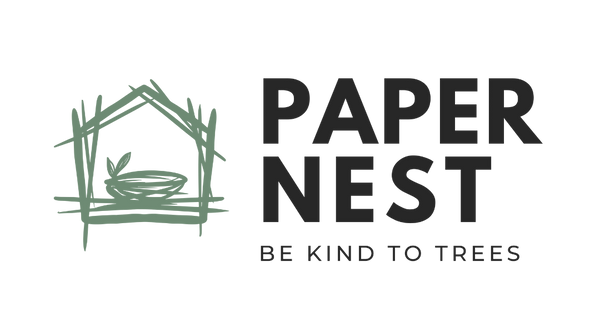Understanding the Environmental Impact of Traditional Paper and the Need for Change
At Papernest, we believe that beautiful stationery shouldn’t come at the cost of our forests. That’s why we’re passionate about creating tree-free, sustainable paper — a small but significant way to protect our planet for future generations.
But why is tree-free paper important? Let’s explore.
The True Cost of conventional wood pulp Paper
Most people don’t think twice about the paper they use daily — from notebooks to packaging. But behind every sheet of regular paper lies a harsh reality:
-
Massive Deforestation: Paper production is one of the leading causes of deforestation worldwide. According to the World Wildlife Fund (WWF), the pulp and paper industry accounts for about 13–15% of total wood consumption globally. Millions of trees are cut down every year to feed our paper needs.
-
Water-Intensive Processes: Producing conventional mill made paper uses a staggering amount of water. To create just one A4 sheet, about 10 liters of water are consumed. For large-scale paper mills, this adds up to an enormous environmental footprint.
-
Chemical Pollution: The bleaching and processing of wood pulp require harmful chemicals like chlorine and sulfur, which often end up polluting rivers, soil, and air.
-
Carbon Emissions: Deforestation contributes directly to climate change. When trees are felled and forests destroyed, carbon stored in trees is released into the atmosphere, accelerating global warming.
In short, conventional paper might look innocent, but its environmental impact runs deep.
What is Tree-Free Paper?
Tree-free paper is exactly what it sounds like — paper made without cutting down trees. Instead, it’s crafted from alternative fibers such as:
-
Cotton Rag waste from garment units
-
Agricultural residues like Sugarcane bagsee, coffee husk etc
-
Crop Stubble waste
-
Other plant fibers like hemp, flax, and banana fiber
At Papernest, we turn waste into wonder — giving discarded materials a second life as beautiful, sustainable stationery.
Why Choose Tree-Free Paper?
Choosing tree-free paper isn't just a preference; it’s a conscious decision to:
🌱 Save Trees
Every ton of tree-free paper saves approximately 17 trees, preserving vital ecosystems and biodiversity.
💧 Conserve Water
Handmade tree-free paper requires significantly less water than conventional paper production. Plus, the water used is often recycled within the process.
🌎 Reduce Pollution
Tree-free paper eliminates the need for toxic chemicals used in wood pulp processing, leading to cleaner rivers and healthier communities.
♻️ Support Circular Economy
By using waste materials, tree-free paper promotes recycling and upcycling, helping to create a more circular and less wasteful economy.
💚 Make a Positive Impact
Every purchase of tree-free paper supports sustainable livelihoods, small-scale artisans, and efforts to combat climate change.
Small Changes, Big Difference
Switching to tree-free, handmade paper may seem like a small step, but it’s one with a ripple effect. Imagine if businesses, schools, and homes worldwide made the shift — the collective impact would be profound.
At Papernest, we're proud to be part of this movement. Each journal, calendar, and notecard we create tells a story of hope — that sustainability can be beautiful, functional, and accessible.
Join us in reimagining paper. One sheet at a time.

